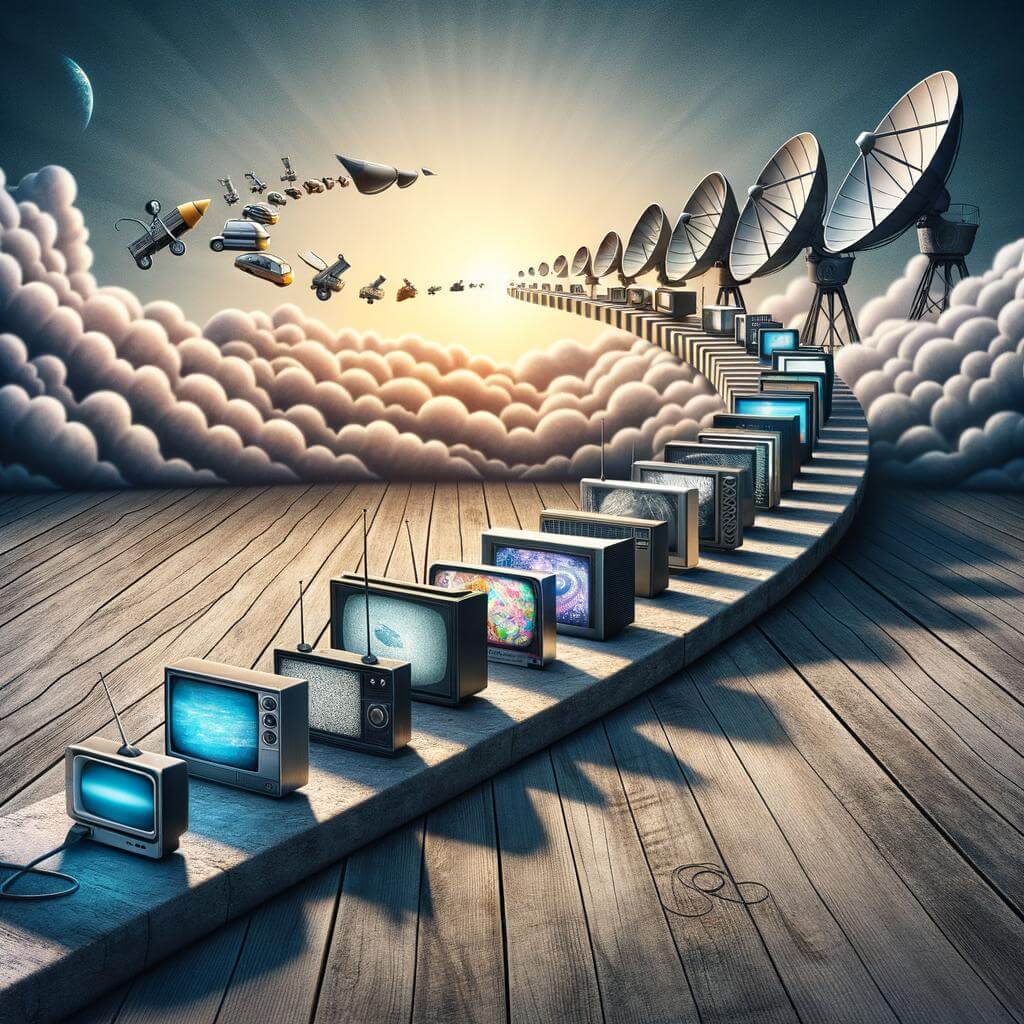
As technology evolves and disrupts conventional industries, one area witnessing a game-changing transformation is television broadcasting. With the advent and rapid spread of IPTV (Internet Protocol Television), traditional cable and satellite TV are finding themselves in an exciting, yet critical battle to retain relevance. Not only does IPTV offer an alternative method of distributing television content, but it also offers tremendous opportunities for more immersive, interactive viewing experiences. In this compelling article, we delve into the considerable influence of IPTV on old-school cable and satellite TV, outlining how and why this Internet-driven service could indeed be the final blow to traditional television broadcasting.
Table of Contents
- Unveiling the Revolutionary World of IPTV: A Threat to Traditional TV?
- Implications on Cable and Satellite TV: Direct Impact of IPTV
- Repositioning Strategies for Cable and Satellite TV in the IPTV Era
- Redefining Television: IPTV a Powerful Disruptor or Complementary Force?
- Q&A
- To Wrap It Up
Unveiling the Revolutionary World of IPTV: A Threat to Traditional TV?

A Revolution in the Making
With the advent of Internet protocol television (IPTV), there’s a wave of revolution in the broadcast industry. IPTV, a system where TV content is sent over the internet, allows viewers to stream their favorite shows without having to rely on traditional transmission methods – a concept boldly challenging the rubric of cable and satellite TV. The increasing popularity and proliferation of IPTV, driven by its attractive features, is threatening to eclipse traditional TV’s monopoly in content distribution.
Advantages of IPTV
Some key points that give IPTV an edge over its traditional counterparts include:
- Interactivity: Unlike traditional TV, IPTV viewers can interact with the content. They can pause, rewind, or skip content according to their preferences.
- Device Mobility: IPTV can be accessed through various devices, including smartphones, tablets, laptops, etc., breaking the physical barrier of traditional television-favoured living rooms.
| IPTV | Traditional TV | |
|---|---|---|
| Portability | Possible on multiple devices | Restricted to one location and device |
| Interactivity | Innovative features like pause, play, rewind | Passive viewing with no interaction |
| Global Accessibility | Accessible anywhere with an internet connection | Geographically limited |
With digital innovation revolutionizing entertainment’s landscape, the traditional TV broadcasting model is no doubt under increasing pressure. Only time will determine if IPTV will be the nail in the coffin for traditional TV or if they can co-exist in this rapidly evolving digital marathon.
Implications on Cable and Satellite TV: Direct Impact of IPTV

IPTV (Internet Protocol Television) is making waves in the realm of entertainment, disrupting traditional methods like cable and satellite TV. As more people turn towards the internet-based streamlining services, there is a direct impact on cable and satellite TV.
The first implication of IPTV on cable and satellite TV is Consumer Control. With IPTV, viewers have the ability to stream content on demand at their convenience, offering personalized TV experiences. Furthermore, IPTV doesn’t only depend on scheduling, thus it provides audiences with the liberty to consume content whenever they want. This aspect denotes a significant shift from the traditional broadcast model where viewers had to follow a fixed schedule.
| Traditional TV | IPTV |
|---|---|
| Fixed Schedule | On-Demand Content |
| Less control over content | High control over content |
In terms of the Economical Aspect, IPTV provides viewers with an a-la-carte type of service, allowing users to pay only for channels they want to watch. This payment model is very attractive to viewers dissatisfied with the exorbitant pricing model of cable and satellite TV subscriptions.
On the contrary, cable and satellite TV force viewers to subscribe to a package of channels, often including some they don’t watch. This scenario has made viewers reconsider their subscriptions and look for alternatives, with many turning to IPTV.
| Traditional TV | IPTV |
|---|---|
| Compulsory package subscription | A la carte channel selection |
| High subscription cost | Cost effective |
Looking at these factors, it becomes evident that IPTV offers a more flexible and cost-effective viewing experience, making it a potent disruptor to traditional forms of television broadcasting like cable and satellite TV. The users of the new generation seek content that is easily accessible and cost-effective, and IPTV provides exactly that. Cable and Satellite TV companies must transform their services to accommodate this new wave of consumption or risk becoming obsolete.
Repositioning Strategies for Cable and Satellite TV in the IPTV Era

The age of IPTV (Internet Protocol Television) has posed significant challenges for traditional cable and satellite TV providers. Having been the primary mode of content delivery for years, cable and satellite TV now find themselves in a fierce competition with IPTV, which offers advantages such as flexibility, interactivity, and cost-effectiveness. Repositioning strategies are, therefore, crucial for these providers to maintain their market share and remain competitive.
Firstly, providers need to tap into the innovation that IPTV offers. Transitioning towards a “Hybrid” model, which combines the traditional broadcasts with the benefits of IPTV, is a popular strategy. This includes adding features such as Video-on-Demand (VoD), interactive advertisements, and personalised content. Additionally, embracing Over-The-Top (OTT) content can attract the younger demographics, who are moving towards platforms like Netflix and Amazon Prime.
| Strategy | Benefits |
|---|---|
| Hybrid model | Increased interactivity, VoD feature |
| OTT content | Attracts younger audience |
Secondly, price restructuring is crucial. Since IPTV’s subscription-based model often proves more cost-effective, providers should consider switching from a fixed-fee to a value-based pricing model. This would allow customers to pay only for channels or content they watch, increasing customer satisfaction and retention rates.
Providers are also recommended to invest in building customer relationships. This can be achieved by investing in high-quality customer service, offering subscriptions with better value, or tailoring content packages based on individual viewing habits.
| Strategy | Benefits |
|---|---|
| Value-based pricing model | Higher customer satisfaction, retention |
| Building customer relationships | Personalisation, high-quality service |
Traditional TV providers can no longer rely on the old ways in this rapidly changing digital age. Embracing innovation, rethinking pricing structures, and prioritising customer relationships are key to maintaining their place in the market. The IPTV revolution is here – those that adapt will thrive.
Redefining Television: IPTV a Powerful Disruptor or Complementary Force?

As we delve into the age of digitization, every industry is experiencing some transformation. IPTV (Internet Protocol Television), a technology that transmits television broadcasts over the internet, is one such ground-breaking revelation that has been making waves in the television industry. Its inception has raised questions of whether it will eventually overthrow traditional cable and satellite TV or simply boost its effectiveness by offering a plurality of choices to the viewers.
But the key points to ponder are:
- IPTV’s potential to offer customized content and on-demand services.
- The ability for viewers to watch content on various devices.
- Better picture quality and no reception issues as compared to traditional methods.
table class="wp-table"
Q&A
Q: What is IPTV?
A: IPTV stands for Internet Protocol Television. It uses internet-based technology to digitally stream television programs, movies, and audio content to your device, be it a smartphone, a laptop, or a smart TV.
Q: How is IPTV different from traditional cable and satellite TV?
A: Unlike traditional cable and satellite TV, which broadcast programs at specific times, IPTV allows users to stream content on demand. It offers improved picture quality, advanced recording features, two-way communication for interactive services, etc.
Q: What is the impact of IPTV on traditional cable and satellite TV?
A: IPTV allows for a much more personalized and flexible viewing experience which has led to a significant number of cable and satellite TV subscribers migrating to this digital platform. It has been reducing the market share of traditional TV services which has forced them to innovate to stay competitive.
Q: How does IPTV provide a personalized user experience?
A: IPTV platforms often have highly interactive interfaces that allow users to personally select what they want to watch, when to watch it, and on what device. Some IPTV services also offer features like personal video recorders (PVRs), which allow viewers to pause, rewind, or fast-forward through their favorite shows.
Q: How are cable and satellite TV companies responding to the rise of IPTV?
A: Several cable and satellite TV providers are offering their content on the internet as IPTV to retain their subscriber base. These companies are also investing in offering interactive television services and combining television with internet services in a package deal.
Q: Does the rise of IPTV mean the end of cable and satellite TV?
A: Not necessarily. There will still be a market for cable and satellite TV, especially in areas where internet connectivity is scarce or inconsistent. However, the growth and popularity of IPTV cannot be overlooked and will certainly influence the future of television broadcasting.
Q: What is the future of IPTV?
A: With advancements in technology and improved internet infrastructure, IPTV is set to grow exponentially. It has the potential to completely transform the TV industry by offering better personalization, convenience, interactivity, and diversity in content than traditional cable and satellite TV.
Q: Is switching from traditional TV to IPTV a good decision for the average consumer?
A: This depends on what the consumer values most. If instant access to a broad range of global content, higher quality streaming, and the ability to watch content on multiple devices is important, then IPTV is definitely a good choice. However, the decision should also factor in network stability in your area, as IPTV relies heavily on internet connectivity.
To Wrap It Up
As we conclude, it’s apparent that IPTV has not only revolutionized TV viewing experiences but also has significantly coerced the traditional cable and satellite TV sectors into a critical remodeling phase. IPTV’s popularity is surging not merely for functions such as on-demand content, internet accessibility, and advanced interactivity, but also for its cost-effective rates. Traditional service providers are now compelled to adapt to these digital trends and restructure their service deliveries to retain their subscriber base. The interplay between IPTV and traditional TV services is indeed a fascinating development to watch, with the future of broadcasting evidently striding towards digital transformation. Engage with the IPTV revolution today, and be a partitive part of this exciting shift in the television industry landscape!
